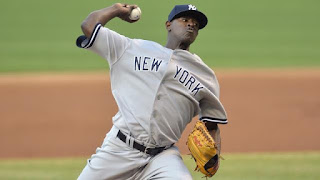Chad Green’s lack of a quality secondary pitch explains his recent struggles
Chad
Green exploded onto the scene last season as he put together one of the
greatest seasons by a Yankees’ reliever since Mariano Rivera donned the
pinstripes. He struck out 13.43 hitters per nine innings, accumulated a 1.83
ERA and a 2.4 WAR, and was arguably the MVP of the Wild Card game for the
Yankees. While it would have been surprising if he pitched better in 2018, expectations
were still high coming into this season. For the most part, he has lived up to
his breakout season. However, in July, he has been a lot more hittable, and he
has seen his ERA skyrocket to 2.74, when it was as low as 1.91 on July 8.
In his last six outings, he has a 1.019 OPS against
to go along with a 7.71 ERA. He also allowed three inherited runners to score
that weren’t charged to him. To put his performance into words, he’s pitched
terrible for the good part of July and has cost the Yankees some games as he
has a loss and blown save in this same time span.
On
the season, he has shown regression and increased hittability in a multitude of
categories beyond the basic ERA, strikeout rate, etc. His percentage of strike
calls looking is down six percent, meaning hitters are jumping on his pitches
in the zone more and not getting fooled nor frozen as much. His foul ball
strike percentage is up eight percent, meaning hitters are making contact more
often and swinging through his pitches less often, which makes sense
considering his 5.3 percent decrease in swinging strikes and whopping 12
percent increase in contact percentage.
One
could argue his .294 BABIP could be the root cause of his struggles as he
simply could just be getting unlucky this season in terms of where hitters are
placing the ball. However, Green ranks 17th amongst all pitchers with at least
40 IP in hard contact percentage at a high 43.7%. So, Green is letting up more
contact at higher exit velocities, which is a major problem.
So,
what is the problem? His average fastball velocity has actually been better in
2018 than last season, 96.3 mph this season compared to 95.8 last season. His
average against his fastball is way up this from .110 to .203, but a .203
average against is still a very respectable number. I believe this almost
doubling in average against his fastball is not a knock on his fastball, but
rather a representation of how little confidence and execution he has for his
secondary pitches.
Chad
Green ranks second amongst all pitchers with at least 40 innings pitched in
fastball usage. Green is second to only the Dodgers’ closer, Kenley Jansen, in
fastball percentage at 88.1%. Jansen throws primarily a cut-fastball, which is
such a solid pitch, that he can get away with throwing essentially only one type of pitch to
opposing hitters and still get results. Green’s fastball is an above
average pitch, but is not at the point where even if hitters know it is coming,
it is unhittable.
Green
has thrown 834 pitches this season, 735 of which have been fastballs. The other
99 have been all sliders, and it is not an exaggeration to say that it has been
a downright awful pitch. Hitters are hitting an insane .417 versus his slider,
which he has thrown to only 25 hitters. This has caused Green to essentially
become a one-pitch pitcher, making him way more predictable and easier to time.
Last
season, Green still threw his fastball a majority of the time, but did so at
only a 67.7% rate. The average against his slider, which he threw 255 times
last season sat at a .203 mark. Also, he threw a cutter, sinker, and a splitter
at least eight times. While these three aforementioned pitches were only thrown
a combined 110 times, the fact that he could throw another pitch other than his
fastball or slider at any given moment kept hitters on edge and further
enhanced his fastball.
Green’s
biggest issue is that he has become extremely predictable. Nine times out of
ten an opposing hitter will be delivered a fastball, so there isn’t much of a
mental approach when facing Green other than acknowledging that he has a slider
that results in a hitter reaching base over 40% of the time. Teams have way
more in-depth scouting and analytics than the tendencies I found on Fangraphs,
but even these basic pitch distributions reveal so many weaknesses for a relief
pitcher who has been one of the best in the American League since the start of
last season.
The
2018 version of Chad Green is a one-pitch pitcher, whose secondary pitch gets
absolutely hammered every time it is thrown. I do not know whether it is his
loss in confidence in his slider that has resulted in him throwing it less or
the Yankees’ analytics department that has told him to stop throwing it because
it is so hittable. He doesn’t start games anymore, so having a wide array of pitches
isn’t that necessary, however, it does not make sense to me why he ditched his
cutter all together, when opposing hitters hit only .235 against it. At the very
least, it is another pitch hitters have to worry about him potentially
throwing. Regardless of the origins of these changes in his pitching, this is a
major issue, which needs to be addressed since Green is a key piece to a lethal
bullpen.
Article
by: Ryan Thoms
Follow @RyanThoms_
Follow @BronxBomberBall



Comments
Post a Comment